When it comes to building new websites and web applications, your choice of a development framework is crucial. There are many options available to choose from. If you’re not sure where to start, it’s a smart idea to consider using a popular framework, as they’re generally tried-and-true options.
The most common development frameworks enjoy a lot of goodwill from developers and users alike. More often than not, this is due to the many benefits these frameworks have to offer. Also, when you select a popular framework for your project, you can easily gain access to helpful support whenever you need it.
In this article, we’ll discuss the benefits of choosing a ‘big name’ framework for your web development work. Then we’ll look at 11 of the top options. Let’s get to it!
The Benefits of Choosing a Popular Web Development Framework
When it comes to creating websites, there are so many options out there to choose from. In fact, it can quickly become overwhelming.
However, it’s important to carefully consider which framework you use, because it can make all the difference in your web development experience. The right solution can significantly enhance your efficiency and workflow, and influence the features and tools that are accessible to you as you work.
Furthermore, when you’re trying to decide on which framework to use for your development projects, it’s often smart to begin by considering the most popular options. Put simply, the commonly-used frameworks tend to be the most established and credible tools. In other words, they’re popular for a reason.
These frameworks are generally more used, and therefore more reliable than newer or lesser-known options. Another benefit is that because well-known frameworks tend to have larger user bases, you’re guaranteed to have a community of developers and a wealth of knowledge to tap into if and when you need guidance or support.
You can think of it like trying to decide on a plugin to use for a WordPress site. You’re likely going to feel more confident and comfortable with an extension that’s been endorsed by hundreds or thousands of developers, rather than with one that has very few users. The same thinking applies when selecting a framework.
How We Chose the Most Popular Frameworks
As a team made up largely of developers and web development professionals, we understand the importance of using the right framework. Aside from our first-hand experience, we’ve also done extensive research to consider the opinions of developers on platforms such as Github and StackOverflow.
We recognize that some frameworks are better suited for front-end development, while others are geared more towards back-end development. This is why we selected popular frameworks that are used in both arenas.
Additionally, for each framework, we’ve considered the types of projects it’s used for, as well as any dependent languages. The result is a well-rounded list that has something to offer for nearly every type of web developer.
11 Most Popular Frameworks for Web Development
Now that you have a bit of background on how we determined which frameworks are most widely and commonly used, it’s time to introduce the top options. Without further ado, let’s take a look at 11 of the most popular frameworks for web development.
1. React

Technically, React is more a front-end JavaScript library than a development framework. However, many web developers consider it to fit into the latter category as well, thanks to its component-based architecture. It was one of the first frameworks to leverage a virtual Document Object Model (DOM), which enables you to make changes to data in a document without affecting its presentation in the browser.
Created in 2013 and maintained by Facebook, React serves as an open-source framework that is made up of a library ecosystem and reusable User Interface (UI) components, which can be used for both server- and client-side web development projects. For example, it’s a powerful tool for building e-commerce and retail sites.
Part of React’s popularity can also be attributed to its fast performance and scalability. In addition to working well alongside Search Engine Optimization (SEO) efforts, it uses Server-Side Rendering (SSR) that many social platforms, including Instagram and Twitter, rely on.
Another of the unique benefits of using React is that it’s easy to learn if you’re already familiar with HTML and CSS. It also uses JSX syntax that makes picking it up easy, and it’s backed by a robust, dependable community of developers.
2. ASP.NET
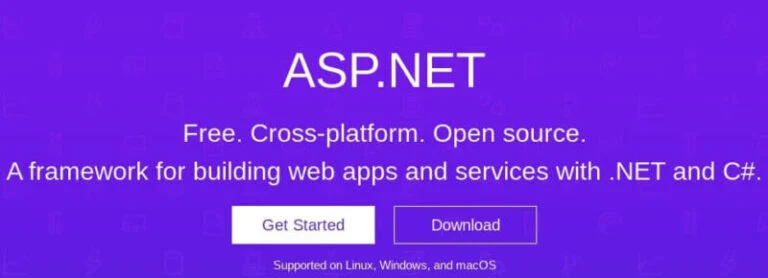
ASP is a website framework with a handful of iterations, including ASP Classic, ASP.NET, and ASP.NET Model-View Controller (MVC). Built by Microsoft, ASP.NET is a framework that can be used to create both desktop and mobile applications, including rich and dynamic websites, web pages, and online portals.
This is a lightweight framework that primarily uses C#. However, one of the unique advantages of ASP.NET is that it’s created with compiled languages. Considering that it uses multiple programming languages, you can leverage it to create a variety of applications with built-in speed and scalability.
The ASP.NET framework can run on any language that uses .NET. This makes it an effective back-end framework option if you’re running, for example, a Microsoft stack. You can also use this open-source, server-side framework on macOS, Linux, Windows, and more. Some notable examples of websites built with ASP.NET include StackOverflow and Getty Images.
3. Angular
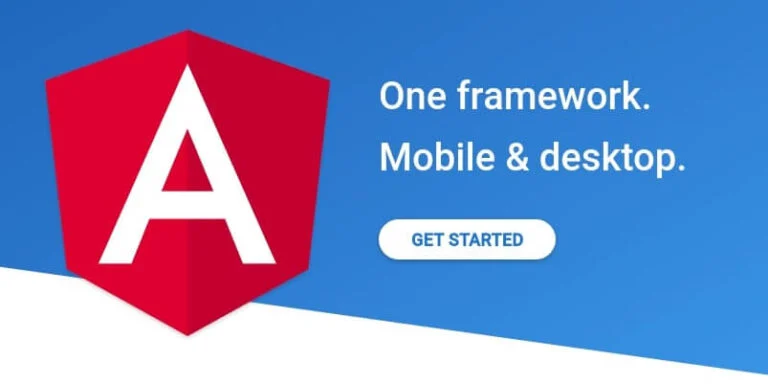
Also referred to as AngularJS, the Angular framework comes from Google, which helps solidify it as one of the most popular options out there. This open-source JavaScript framework is particularly useful if you’re building large-scale, high-performance web applications and websites. It’s even been used to create sites like Netflix.
While it’s not entirely a full stack framework, Angular can be used as a front-end framework for building client-side applications and single application web pages (for both mobile and desktop). In addition to HTML and CSS, Angular uses Typescript, which is a JavaScript superset. It also comes with tools that help you achieve consistent coding in your projects.
There are a few downsides to Angular. For example, it’s much larger than other frameworks, and it’s also not as SEO-friendly. However, there are plenty of resources and tutorials available online that can help you make the most of its features.
4. Ruby on Rails
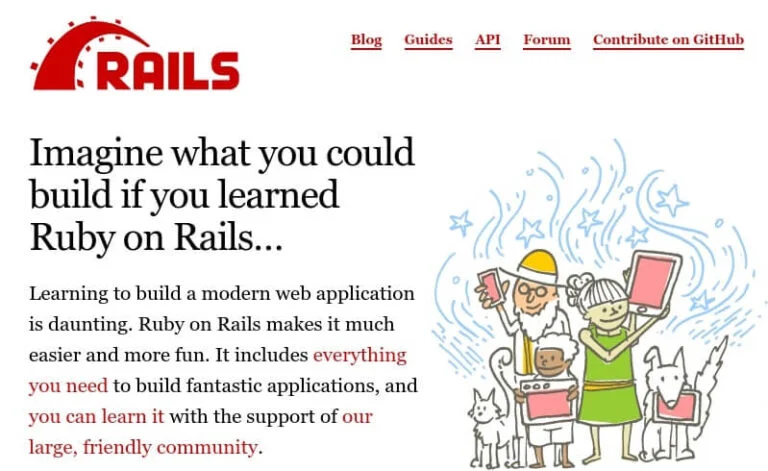
Commonly referred to as ‘RoR’, the Ruby on Rails framework is one of the most popular options out there. Written in 2005 by David Heinemeier Hansson, Ruby on Rails is a free, open-source framework that runs on Linux and comes with everything you need to develop web applications quickly.
It also uses Ruby and a Model View Controller pattern that is useful for developing database-driven applications. As one of the earlier back-end frameworks, Ruby influenced many of the solutions that came after it, such as Angular and Vue.js. Some of the most notable users of Ruby on Rails include Hulu, AirBnB, Shopify, and Github.
One of the downsides of Ruby on Rails is that it can require a bit of a learning curve, as well as time and effort to deploy and run it in production environments. However, thanks to the large community and plethora of resources and tutorials available, it’s also a decent option for beginners to consider.
5. Vue.js

Vue.js is another popular JavaScript framework for web development. It’s considered a progressive option that includes a component architecture, and a scalable ecosystem that’s useful for building front-end applications.
One of the biggest advantages of using Vue.js is its versatility. Depending on the complexity of your project, you can use it as a JavaScript library or a complete front-end framework.
One downside to consider is that it’s not supported by some of the biggest digital giants such as Facebook and Google. However, as a framework, it is generally user friendly.
If you already know HTML, CSS, and JavaScript, you can begin building your applications almost immediately. There is also a wide assortment of video courses, guides, and documentation you can access to help guide you along.
6. Django

Django is a Model View Template (MVT) framework that runs on the popular programming language Python. Created in 2003, this free, open-source framework is used by Instagram and built on helpful development philosophies such as Convention Over Configuration (CoC) and Don’t Repeat Yourself (DRY) patterns.
It categories itself as a “batteries included” framework, coming with a ton of helpful features and tools. This includes authentication and admin interfacing, temporary and sessions-based messaging, and Google sitemap XML generation.
Django also incorporates an Object Relational Mapping (ORM) feature that simplifies the database and development processes. It can be used for full stack development or just as a back-end framework, and supports a variety of database systems including MySQL and PostgreSQL.
In addition to being a scalable and versatile framework that is easy to learn, Django is also a highly-secure framework that includes a handful of security features out of the box, such as the ability to prevent code execution in the template layer. Therefore, if you’re looking to create websites that have top-notch security, Django is worth checking out.
While features such as ORM are generally an advantage, they can also make working with the framework in order to build your applications a bit more difficult. However, once you get past the learning curve, it can be an invaluable tool.
7. Laravel
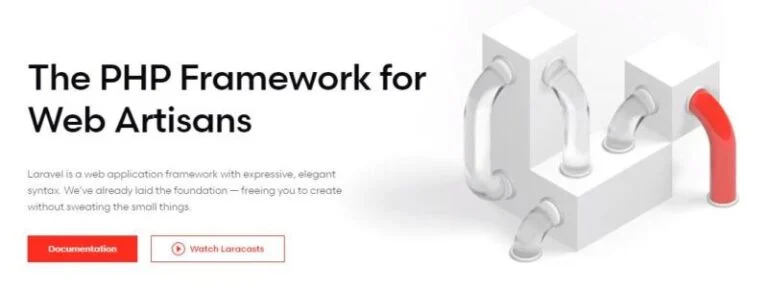
Created in 2011 by Taylor Otwell, Laravel is one of the newer frameworks to be included on this list. It uses the MVC architectural pattern, and is largely popular for running on PHP, a primary programming language.
Some of the advantages of using Laravel are that it comes with API support, and it offers a library of modular packages and tools for extending its purpose and functionality. This helps to make it a full stack framework, which can be used to create a wide variety of applications.
The platform also offers Laravel Vapor. Powered by Amazon Web Services (AWS), this solution provides you with a serverless deployment platform that includes on-demand auto-scaling and no maintenance.
Another benefit to consider are the accessible Laracasts. This is a collection of hundreds of video and screencast tutorials that help you get familiar with the development framework ecosystem, so you can use it to build your web applications with ease.
8. Express
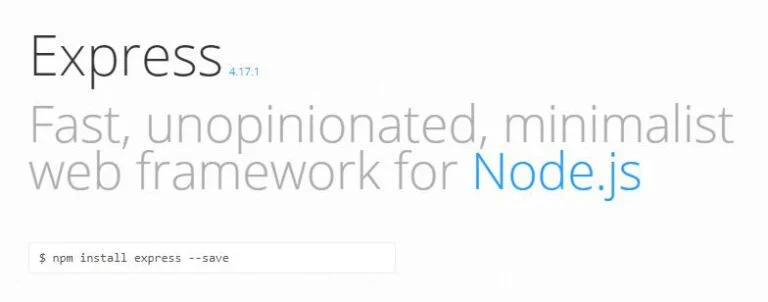
Express is the minimalist framework of Node.js. This free, open-source framework is based on JavaScript, and supports full applications for both mobile and web, as well as REST API. It’s the back-end standard of MEAN stack, and has been used to create sites such as MySpace and Storify.
One of the main draws of Express is that it’s both fast and flexible. Most of the features are available as plugins. As such, it can provide you with an expedited and streamlined process of creating applications based on Node.js.
Additionally, it offers web development features that won’t interfere with the Node.js framework functionality. A variety of other frameworks are based on Express, including Sails, Loopback, and Nestjs.
9. CodeIgniter
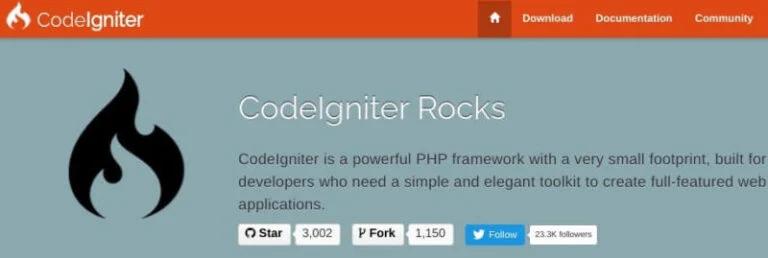
CodeIgniter, which was created by EllisLab, is a popular PHP framework for developers looking to build dynamic sites. What distinguishes this solution from many others is that it requires next to no configuration. It also features an enormous collection of monolithic libraries.
Although CodeIgniter shares some similarities to frameworks built on the MVC architecture, models and views are offered but not required. It’s been used to build websites such as Guardian and Bufferapp.
CodeIgniter is also a lightweight framework, and is an ideal choice if you’re looking for superior performance and strong security. Plus, thanks to its clear documentation and ‘how-to’ guides, you can get to know its ins and outs in no time.
This option might not be as intricate or feature-rich as other development frameworks on this list. However, it may be the perfect choice if you’re looking for an elegant yet simple foundation for building web applications.
10. Ember
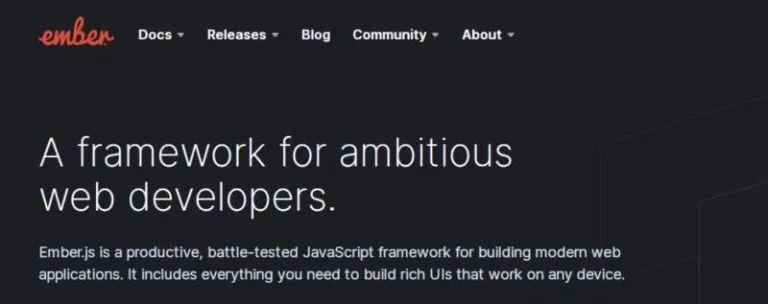
If you’re an experienced web developer looking for a robust and reliable framework, Ember is a solid option worth considering. This JavaScript framework, first released in 2011, is popular among seasoned developers. It features an impressive array of core features and tools that make building complex web applications easier.
Used by companies such as Netflix, LinkedIn, and Apple, Ember boasts itself as a “framework for ambitious developers”. It has a massive, supportive, and helpful community that is composed of dedicated developers who are passionate about its ability to enhance their productivity.
Some of the biggest advantages of using Ember are its organizational features and advanced version management system. The framework also includes useful binding capabilities, such as offering the option to create properties out of functions.
Of course, considering that it’s a framework geared towards experienced developers for building modern applications, it may not be the best option for beginners. However, if you do want to give Ember a shot, there are plenty of documentation articles and resources included on the main website to get you started.
11. Spring
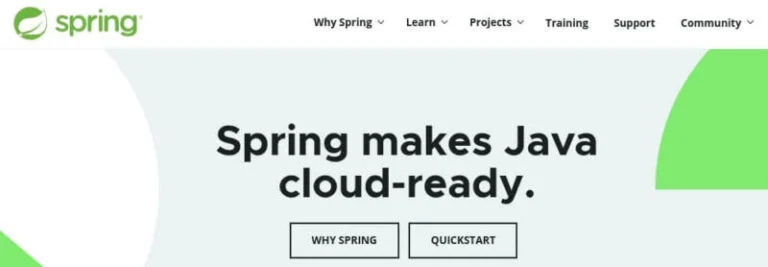
Last but not least, Spring is a MVC framework that uses the famous Java language, which makes it popular among many professional web developers. It’s designed for creating complex, high-performance enterprise sites. Some examples of websites it has been used to build include Ticketmaster and Wix.
This web application development framework prioritizes speed and productivity. One of its unique advantages is that it uses Inversion of Control (IoC) and Dependency Injection (DI) features that support a full suite of tools and functionality. It also comes with flexible libraries and collections of extensions that offer you versatility and extensibility when building your applications.
In addition, Spring has a lot to offer in terms of security and support. The framework is regularly monitored, tested, and patched. There’s also a Spring Security framework that includes built-in access control and customizable authentication.
The Spring community is an expansive base made up of everyone from beginners to experts. Therefore, there are plenty of training guides and tutorials to get you started. However, a major downside is that unless you’re familiar with Java, working with Spring can be difficult.
Conclusion
Choosing a web development framework for your project can be a rather tricky process. However, there are several ways you can benefit from using a popular solution. You can leverage the various benefits popular frameworks offer, such as enhanced credibility, and rely on a vibrant community of developers.
In this post, we’ve looked at 11 of the most popular frameworks that can be used for your web development projects. The best option for your projects will depend on your experience level, as well as what specific languages you’re looking to use. For example, while React serves as an effective JavaScript library for developers, Django runs on Python, and Laravel is a solid PHP framework.
Aside from a robust and reliable framework, managing your web development projects is a lot easier when you’re using quality web hosting services. Check out our many hosting options to learn more!
Image credit: Pexels.


0 Comments